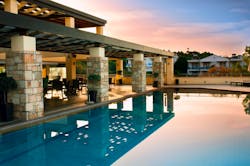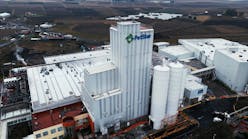There are two main goals for water treatment professionals involved with testing and treating spa or hot tub water:
- Protecting bathers’ health
- Preventing surface and equipment damage
These professionals probably already realize that hot water and small volume pose some challenges to water quality maintenance.
Let’s explore the peculiarities of water sanitation and balance in spas.
Ensuring bather health
Spa water is typically heated at 96 degrees Fahrenheit to 104 degrees Fahrenheit, making it an ideal breeding ground for infection and disease-causing microorganisms such as bacteria, viruses, protozoans and fungi.
For example, the most common spa-related ailment, dermatitis, is caused by the bacteria Pseudomonas aeruginosa. It’s also known that Legionella pneumophila, which causes Legionnaires’ disease, has been known to be transmitted by inhaling water vapor from a contaminated spa.
To complicate matters, water this hot causes bathers to perspire profusely, and a spa’s small volume creates a very high bather-to-water ratio.
Two people in a 500-gallon spa are equivalent to 100 people in a 25,000-gallon pool (both contain one person for each 250 gallons of water). Bather wastes along with dirt, dust, pollen and other environmental detritus create a high sanitizer demand (the amount of sanitizer needed to react with all contaminants before any germ-killing residual is available).
For these reasons, it is vitally important that a proper sanitizer level be maintained at all times, and the water must be periodically treated with a supplemental oxidizer to eliminate the organic pollutants so the sanitizer can work unimpeded.
Sanitizers kill germs
Hot water causes chemical reaction rates to increase. This means it is possible for two people in a 400-gallon spa to deplete a sanitizer residual of 1 ppm free chlorine or 2 ppm bromine in just 15 minutes.
Chlorine and bromine are the two sanitizers most commonly used in spas to eliminate microbial contaminants. Various forms are available, each having unique characteristics.
Chlorine
Any chlorine compound added to water forms the powerful sanitizing and oxidizing combination of hypochlorous acid and hypochlorite ion (for simplicity, often called free chlorine).
Free chlorine immediately reacts with contaminants in the water, forming chloramines (combined chlorine), which cause objectionable odors as well as eye and skin irritation if allowed to build up.
The goal is to always keep an adequate residual of free chlorine in the water, while eliminating all combined chlorine. Chlorine’s sanitizing and oxidizing effectiveness is highly dependent upon the water’s pH, which can change rapidly in a spa due to its small volume.
Free chlorine is also susceptible to degradation by the UV rays in sunlight; however, this loss can be slowed by cyanuric acid (CYA).
Stabilized forms of chlorine, sodium dichlor for example, already contain CYA in their formulas. Non-stabilized chlorines, such as lithium hypochlorite, do not. Outdoor spas treated with these products require separate addition of CYA.
Bromine
Bromine has several advantages over chlorine for spa use. When bromine is added to water, it forms the sanitizer and oxidizer hypobromous acid.
Hypobromous acid reacts with contaminants resulting in bromamines. Unlike chloramines, bromamines are good sanitizers and cause no objectionable odor or irritation.
There’s no reason to eliminate bromamines because they self-destruct quickly, becoming hypobromous acid, bromide ions, hydrogen ions and nitrogen gas.
Amazingly, the bromide ions — often referred to as the bromide bank — can be regenerated to hypobromous acid by chlorine, ozone, or potassium monopersulfate. (See diagram next page.)
Another benefit of bromine is that its effectiveness isn’t significantly affected by pH changes in the range normally encountered in spa water.
Unfortunately, there is no known stabilizer for bromine that even approaches the effectiveness of cyanuric acid on chlorine, so it is best used in covered and indoor spas.
Ozone
Some spas are equipped with ozonators, which create ozone gas, an extremely powerful but very short-lived sanitizer and oxidizer. Ozone doesn’t eliminate the need for a chlorine or bromine residual, but their use can be greatly reduced.
Oxidation is the process of eliminating organic contaminants from water so the primary sanitizer (usually chlorine or bromine) is free for its main purpose — killing germs.
Oxidation can be accomplished by superchlorinating or shocking the water:
- Superchlorination means adding a large dose of chlorine all at once. Raising the chlorine level to between 5 and 10 ppm will oxidize away impurities. Superchlorinating to 30 ppm will eliminate a green algae bloom.Increasing the free chlorine level to 10 times the combined chlorine level — a procedure called breakpoint chlorination — will eliminate odor- and irritation-causing combined chlorine compounds.
- Shocking refers to the addition of any oxidizing chemical.A non-chlorine shocking agent cannot leave a sanitizing residual, whereas the various chlorine compounds used for this purpose can.The most widely used non-chlorine shock is potassium monopersulfate (MPS). Its chief advantage over chlorine shocks is that bathers can re-enter the spa much sooner. But while MPS-based products will rid water of organic contaminants, they will not eliminate combined chlorine like breakpoint chlorination.
A balanced approach
Spa treatment is often called "teaspoon chemistry" because a little dose of chemical goes a long way in such a small volume of water.
Always test the water before adding any treatment. To prevent damage from corrosion or scaling, as well as bather discomfort, three interrelated parameters must be balanced
- pH
- Total alkalinity
- Calcium hardness
pH
Spas, due to their small volume, are prone to fluctuations in pH, so this parameter must be monitored closely.
Water with low pH can cause corrosion of metal components and plaster pitting, eye and skin irritation, and chlorine loss.
Water with high pH can lead to crusty deposits on plumbing and surfaces, cloudy water, poor chlorine disinfection, and eye and skin irritation.
Total alkalinity
Total alkalinity is a measure of the alkaline materials (carbonates, bicarbonates, hydroxides, etc.) dissolved in the water, which have a great effect on pH.
If total alkalinity is too low, pH becomes difficult to control, bouncing around when even small amounts of treatment chemicals are added. High total alkalinity causes pH to drift upward and makes lowering it difficult.
Keeping total alkalinity in its proper range will buffer the water from wide swings in pH.
Calcium hardness
Water with low calcium hardness will aggressively seek more by dissolving it from points of contact. Water with high calcium hardness has a greater tendency to deposit rough, unsightly scale on surfaces and equipment.
High water temperature increases the propensity for scale formation, particularly on heater elements. If allowed to accumulate, these deposits will cause increased water pressure, reduced circulation and inefficient heating.
Total dissolved solids (TDS)
Another important measurement of spa water quality is total dissolved solids (TDS). Hot, jetted water evaporates more quickly than still water, leaving behind any impurities that were dissolved in it.
Repeated evaporation and topping off causes TDS to build up, which can contribute to corrosion of spa components and cloudy water.
TDS cannot be lowered through chemical treatment. Instead, partially drain the vessel and refill it with lower-TDS water.
Testing determines treatment
Regular testing is a must with spas:
- pH and sanitizer levels should be checked before and after every use
- Total alkalinity should be checked weekly
- Calcium hardness, TDS, metals, and cyanuric acid (if used) should also be monitored, though less frequently
Test strips and test kits employing liquid reagents are used for analyzing spa water quality.
Consistency in the color standards from print run to print run is an important feature with test kits. Being able to measure combined chlorine as well as free chlorine is also an important consideration when choosing testing materials.
If maintaining a chlorinated pool and a brominated spa, a product that measures both parameters is helpful.
With test strips, moisture is the enemy. A product utilizing a container that prevents wet fingers from spoiling the dry pads and has desiccant inside to absorb humidity should be considered.
Liquid kits should have reagent bottle caps color-coded to the test instructions, and molded fill marks instead of printed ones that rub off over time.
Since testing is only the bridge to treatment, dosage charts and a water balance calculator are also good to have.
When testing chlorinated water, dealers should pick a method that can differentiate free chlorine. Test strips and test kits with DPD or FAS-DPD reagents will do this. Kits using the OT (orthotolidine) method cannot because they measure only total chlorine.
Also, remember that monopersulfate-based shocks can interfere with liquid-reagent combined chlorine tests, making the level appear higher than it actually is. Always select a kit that can compensate for this interference.
Finally, be sure water quality always meets the guidelines set forth by the National Swimming Pool Foundation (see table, previous page).
|
Parameter
|
Min.
|
Ideal
|
Max.
|
|
Free Chlorine, ppm
|
time wtd. avg.
* For spas sanitized with calcium hypochlorite, lithium hypochlorite, or sodium hypochlorite
** For spas sanitized with sodium dichlor, trichlor, BCDMH, or chlorine gas
*** Dictated by state or local codes. Typically 100 ppm. (Some codes higher, others lower.)
Michael Gardner is communications coordinator at Taylor Technologies, Inc., a Sparks, MD-based manufacturer of water-testing products for pools and spas, potable water and wastewater treatment, boilers and cooling systems, and food processing operations.


